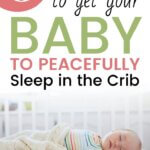Having trouble getting baby to sleep in her crib? Use these tips to get your baby to peacefully sleep in the crib instead of your arms, the swing, or another location.
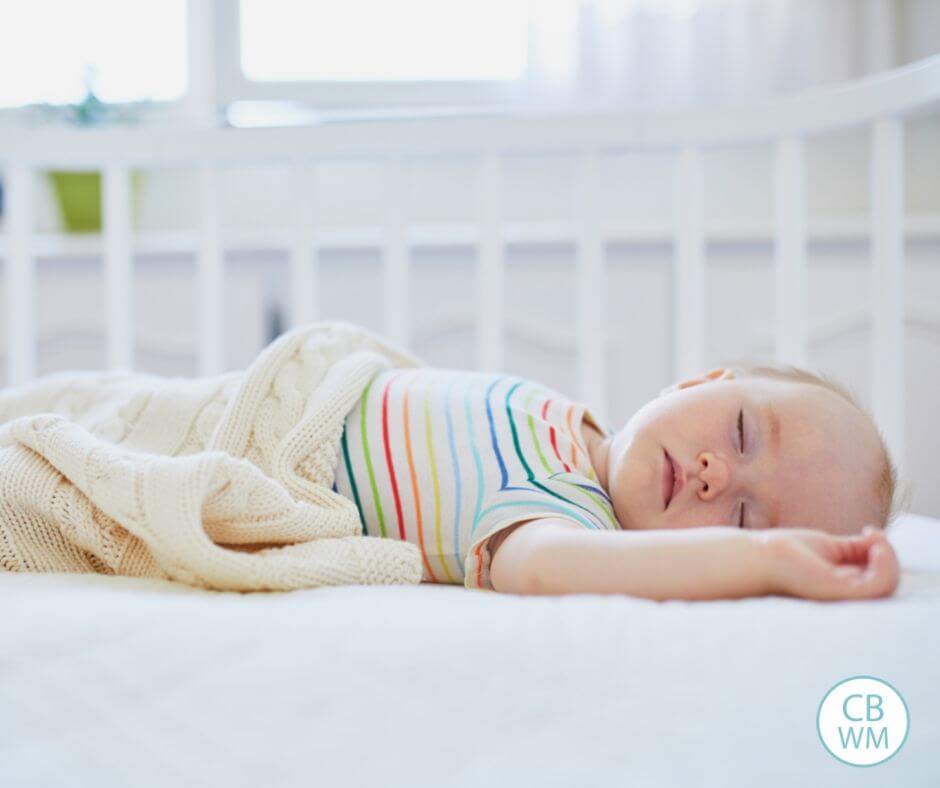
In those newborn days, despite the best of intentions from you, it can be really hard to have baby sleep in his crib consistently. You might have lots of family and friends visiting, baby might have a hard time sleeping, or you might just want time holding your cute baby.
Whatever the reasons you have for baby not sleeping well in the crib right now, your current goal is to get baby to take naps and sleep at night in the crib. You might be wondering how to get baby to nap in a crib instead of arms. You want baby to sleep without being held. You might want to transition baby from one sleep location to the crib.
This post will give you the best tips to help you get baby sleeping in the crib as soon as possible, no matter the age or stage of your baby.
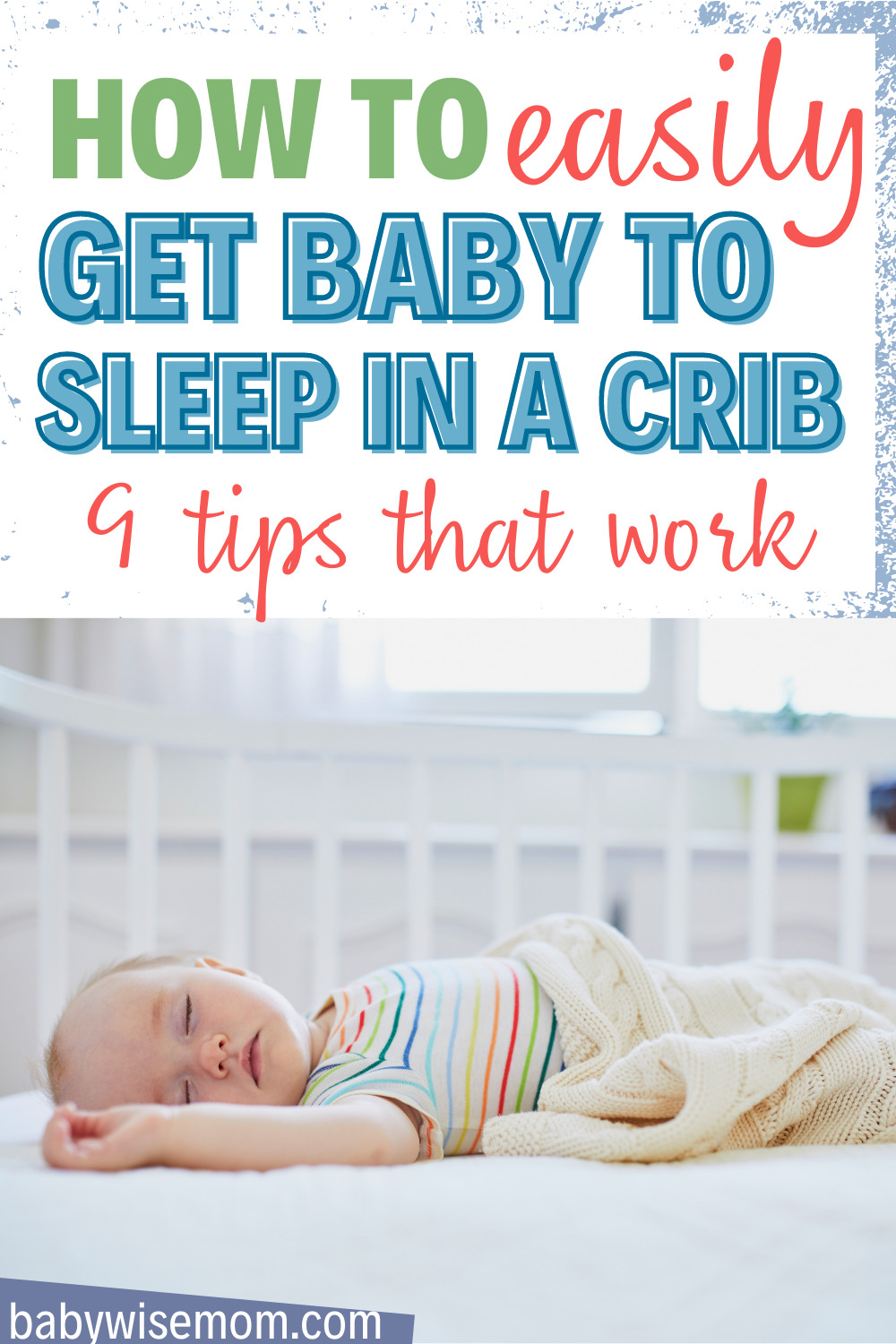
Post Contents
- Begin as You Mean to Go On
- Create a Good Sleep Environment
- Maintain a Sleep Routine
- The Babywise Mom Nap Guide
- Swaddle Baby
- Start Small
- Wean Away from Your Sleep Prop
- Get Baby to Fall Asleep On Her Own
- Establish Solid Sleep
- Thank you!
- Start with a Bassinet
- The Best Age to Move Baby to Crib
- Summary
- Conclusion
- Related Baby Sleep Posts
Begin as You Mean to Go On
I had a variety of experiences with my babies. My oldest was held a lot as a newborn by grandparents and his parents. He had a hard time transitioning to sleeping in a crib.
Because of that, I was much more careful with my three girls who followed and really did my best to in general, start with the end in mind. This doesn’t mean we never held them or that they always slept in the crib. In fact, my youngest slept in a bassinet for a long time (see more on that below).
I have a newborn sleep hierarchy that really helps you get your goals in order and make sure you focus on what is most important first. Be sure you read that to help guide you in setting your goals.
As you read that, take note that the second most important thing for you to focus on with a newborn is that she is sleeping where she should. If you want baby to sleep in a crib at some point, keep that in mind as a goal and start as you mean to go on.
So put a priority on your baby being able to sleep in his crib and establishing good sleep habits from the beginning.
Create a Good Sleep Environment
Do your best to set up your baby’s sleep environment for sleep success.
Have curtains, blinds, or other window coverings to help keep out the sun. Get a white noise machine if needed to block out noise. Be aware of the decorations baby can see from his crib and how that might be stimulating him.
Keep the room at a good temperature (reading Finding the Right Temperature for Sleep) and figure out how your baby best likes to be dressed for sleep. The room temperature really is very important to your baby sleeping well, so don’t overlook it. Overheating leads to poor sleep as does being too cold.
Many babies like to sleep being held because it helps them be warmer. Keep baby warm through the sleep environment, clothes, and the swaddle.
You will of course want ot set up a safe sleep space. Maintain good safe sleep practices as set by the American Academy of Pediatrics (AAP). You do not want a pillow in a baby’s bed (that leads to risk of suffocation) and you do not want toys in a baby’s bed. You also do not want loose bedding. Extra items can increase the risk of SIDS.
You want a firm mattress with tight fitting bottom sheet. Always use fitted sheets with babies. You do not want gaps between the crib and the rails.
Maintain a Sleep Routine
If you do not have a solid nap routine or sleep routine, spend a week or two being super consistent with a sleep routine. This will help signal to your baby that it is time to sleep, even if the location is different than it has been.
You want a consistent routine before naps in the daytime and also a consistent bedtime routine before night sleep. The nap routine and bedtime routine can be the same or they can be different from each other, just keep each one consistent.
If you already have a solid sleep routine, you are ready to go! Keep that routine the same as you move baby to the crib.
>>>Read: Sleep Routine Ideas to Get Your Baby Sleeping Well
Part of your sleep routine needs to be that nap time and bedtime are consistent. A solid sleep schedule will make it easier for baby to fall asleep when it is time to sleep, and baby will get better sleep.
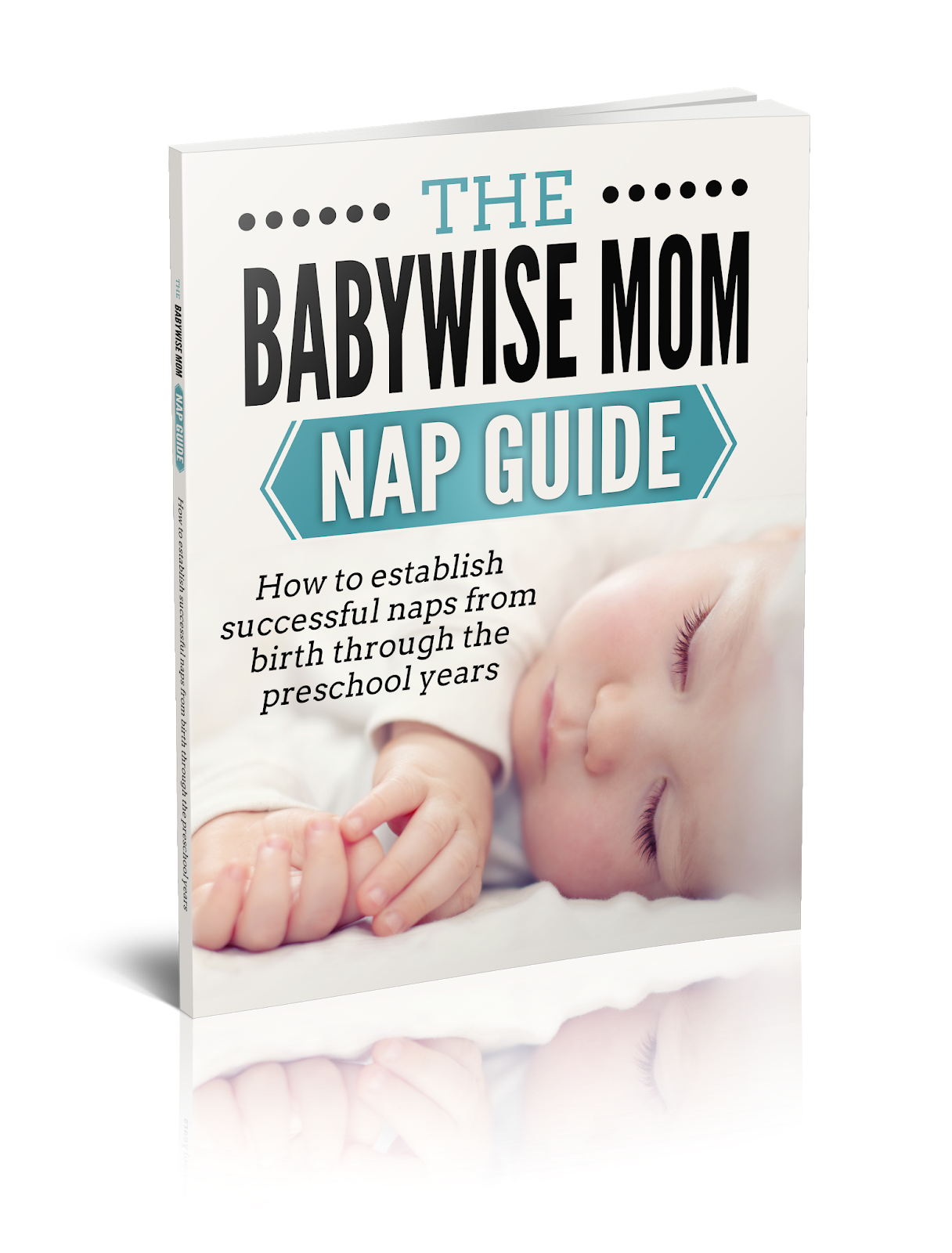
The Babywise Mom Nap Guide
The Babywise Mom Nap Guide eBook helps you establish successful naps from birth through the preschool years. It is a great resource!
Gary Ezzo, co-author of Preparation For Parenting and On Becoming Babywise, states: “Whether it is talking about establishing good nap behavior or offering solutions to sleep disruptions, this is a practical resource that I trust and recommend. The book is well laid out and answers just about every question a new or seasoned mom might have about babies, toddlers and sleep. We view this as more than a nap guided; it is a resource of encouragement that comes with compassion.”
This post may contain affiliate links, which won’t change your price but will share some commission.
Swaddle Baby
A crib can be really large for a young baby. Swaddling baby can help baby feel cozy while sleeping in a big, giant crib.
There are a lot of popular swaddle blankets out there. I always used the SwaddleMe. They are the least expensive of the blankets, so it is a good place to start and see if they work well for your baby.
Other popular swaddle blankets include:
- aden + anais Swaddle Blankets
- Halo SleepSack Swaddle
- Miracle Blanket
- Love to Dream Swaddle UP
- Zipadee-Zip
- Merlin’s Magic Sleepsuit
If your baby is past the swaddle, a sleep sack is a great alternative to help keep the baby warm and feeling cozy. A swaddle can provide the warmth baby needs. Don’t swaddle your baby if they no longer need it–this can lead them to having discomfort and struggle sleeping.
>>>Read: How to Help Your Baby Sleep Better With Swaddling
Start Small
As you set your goal for getting baby to sleep in the crib, no matter the age of your baby, focus on getting baby to nap in the crib for one or two naps each day.
This way, you can still have naps each day where baby is getting good sleep and not getting overly tired. An overly tired baby will not sleep, so you want to make sure baby is still getting good sleep each day.
As baby gets better at sleeping in the crib, you can add another nap.
Another option is to start with night sleep instead of a nap. This can be really effective since it is ingrained in the body to sleep more at night.
If your baby is old enough to have days and nights sorted out, you might find it easiest to move to the crib at night at first and then work toward naps later.
The first nap of the day is the most important nap of your baby’s day, and many sleep experts explain that the first nap is essentially an extension of night sleep. This is a very good nap to aim for having in the crib as you start to have naps in the crib each day.
>>>Read: When To Move Baby To Own Room
Wean Away from Your Sleep Prop
If you are currently putting baby in a swing, car seat, a carrier, or your arms, wean baby away from this. You can start by putting baby in the item but not using the motion of the item. After a few days, you can move baby into the crib.
Some props are helpful tools that you use for a time to help baby sleep better. One example of this is a white noise machine. Other examples include a swaddle and a pacifier.
Other sleep props are a habit you don’t necessarily want to start, or habits you want to break as soon as possible.
Others are potential sleep props that could turn into a problem if used in excess, but can be helpful tools for newborns, especially if baby wakes early.
An example of this is a swing, sling, or stroller. You might use these items at times to extend a short nap. But you don’t want baby to rely on those things for every nap.
If you have been using a swing, car seat, or stroller to get your baby to fall asleep, you can start your weaning process by removing the motion. Baby can sleep in the item but without the motion. Then move toward a bed.
Get Baby to Fall Asleep On Her Own
Sleep training your baby will be very helpful in getting baby to sleep in the crib. A baby who can fall asleep independently typically sleeps better in a variety of locations.
My favorite way to get baby to sleep alone for naps and night sleep is to use the Four S’s. This is a gentle sleep training method.
It is okay for your baby to fuss for a bit while she settles in for a nap or nighttime sleep.
There are many ways to sleep train. You can do the Ferber method. You can do cry it out. You can go in and comfort at set intervals after a certain amount of time.
HOW you do it does not matter. All that matters is that you choose a way to get baby to learn to sleep independently. You want baby to be able to self soothe at sleep time.
As you teach your baby to sleep on their own, it is very important that you recognized their sleep cues that tell you they are ready for a nap or bedtime.
>>>Read: The Big List of Sleep Training Resources
Start with a Bassinet
While you want to start as you mean to go on, it is okay to gradually graduate to bigger beds. My four children all eventually slept on a twin-sized bed, but they did not start there. They got bigger beds as they got older.
With my children, only one really started life in the crib full time.
Brayden was in a pack and play until he was 6 months old due to space limitations in our home. Kaitlyn slept in the crib for half of her naps and bassinet for half. McKenna slept in her crib. Brinley slept in the bassinet that was placed in her crib.
For babies who are not sleeping well because they want something with a cozier feel, a bassinet is a great option.
If you get a bassinet that can come off the base and be a Moses basket-type of situation, you can even set that in the crib to get your little one used to the room and location.
The Best Age to Move Baby to Crib
Are you wondering when you should put baby in the crib instead of the bassinet or other sleep location? There is no one-size-fits-all best age for babies to move to the crib instead of a bassinet or other sleep location.
A baby can sleep in a crib at any age. A newborn can sleep in a crib. Keep in mind that the older your baby gets, the harder it will be for your baby to move to a new sleep location (the crib). I would encourage you to move baby as young as possible–again, that idea of start as you mean to go on.
As young as your baby will sleep in the crib, do it!
Always trust your intuition as the parent. Most parents get to a point when they just feel like it is time to give the crib a go. Trust your mommy instincts.
A lot of moms find 8 weeks old to be a good age to move toward sleeping in the crib.
If your baby is still not sleeping in the crib at three months or older, I would strongly suggest you start immediately.
Summary
The main points to focus on when getting your baby to sleep in a crib are:
Begin as you mean to go on (if you want baby in a crib, remove roadblocks to making this happen)
Create a good sleep environment
Maintain a sleep routine for baby to signal time to sleep
Swaddle baby or use a sleep sack
Start with sleeping in the crib for 1 or 2 naps a day and work up from there
Wean baby from sleep props
Teach baby to sleep independently (sleep training)
Start in a bassinet if needed
Conclusion
As you move your baby from one sleep location to the crib, keep in mind that changes take time. Your baby will most likely need a few days to adjust to the new sleep location.
Stick to this new change! It is hard on babies to go back and forth. Do not start unless you feel ready and committed. With that said, sometimes you try something new for your baby and quickly realize you were wrong and need to wait longer. If that is the case, abandon the change and wait until baby is ready. Just don’t move to crib one day, then back to holding for two days, then back to crib….
Related Baby Sleep Posts
- Sleep Begets Sleep? The Truth About Baby Sleep
- How Long Should a Newborn Be Awake Between Naps
- When To Move Baby to Own Room
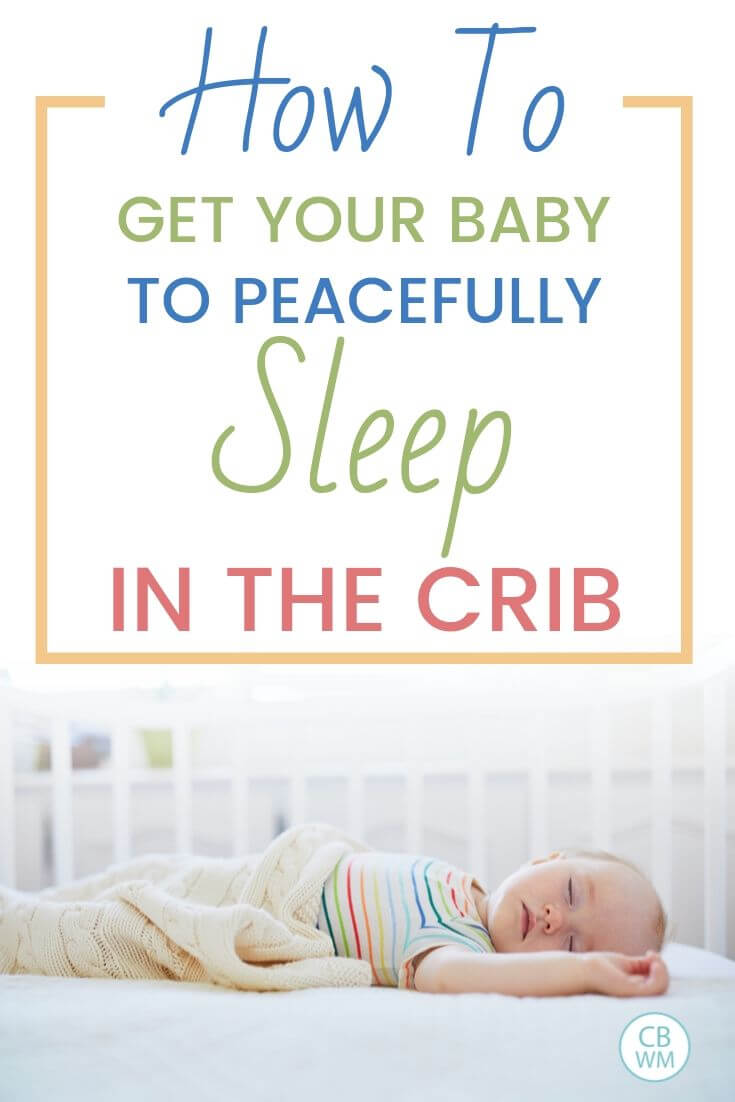
This post originally appeared on this blog in October 2019


